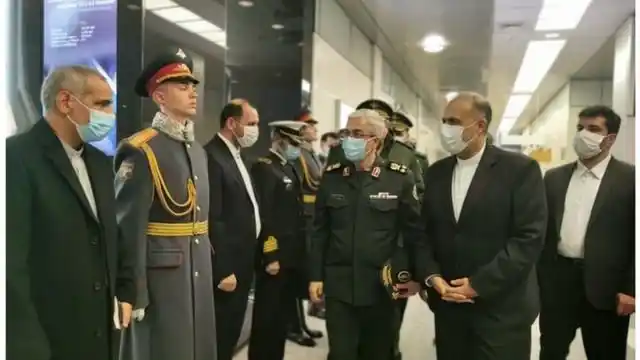The Commander in Chief of the Iranian Air Force General Vahedi confirmed in a televised show that Iran is buying the Sukhoi Su-35E fighter jets from Russia, and that twenty-four of the aircraft are from Egypt’s order which are yet to be delivered due to pressure from the United States. General Vahedi also explained that at least 64 Su-35s will be procured from Russia.
In December last year, Iran and Russia signed a 20-year security and defence agreement under which a 10 billion USD arms deal was reached in January this year. The agreement will see the supply of 24 Su-35s, and two S-400 surface to air defence systems. Iran was first offered the Su-35s in October 2021 during the visit of Major General Pasdar Mohammad Bagheri, Chief of the General Staff of Iran’s Armed Forces to Moscow, however, no deal was reached at the time due to funds constraints in the Iranian side.

At the time, Russia had hoped to sell at least eleven of the 24 jets to Indonesia which is a long time user of the Sukhoi-series cobat jets, however, the Indonesia government was pressured by the United States to reject the deal. In the deal with Iran, Tehran has earmarked $3 billion USD in crude oil barrels in exchange for the Su-35Es in addition to the $10 billion USD arms agreement. As part of the deal, Russia will also carry out life extension and overhaul service of Iran’s 23 MiG-29 fighters and 25 Su-24MK strike aircraft.
An MRO facility is currently being constructed in Mehrabad airport for this purpose. About 30 IRIAF pilots will be sent to Russia for training and conversion to the new Su-35S.
Currently, the Iranian Air Force has 304 fighter planes, half of which are operational at the same time. One hundred and eighty one of them were inherited from the Imperial Iranian Air Force, which purchased them from the US in the 1960s and 70s, and are more than four decades old. Among them, the 60 F-4D/E Phantom 2 fighters, which are about five decades old, are most in need of replacement with advanced fighters.
Although Iran has managed to supplement its Air Force capabilities with a small number of MiG-29, Mirage F1, Chengdu J-7 as well as some reverse-engineered F-5s.
The Sukhoi Su-35 is a 4.5 generation fighter jet based on the successful Su-27. The aircraft features significant upgrades to its avionics and weapon systems. It is also one of the few mass-produced aircraft with thrust-vectored engine nozzles, a system designed to enhance maneuverability and controllability at low speeds.
If acquired by Iran, the Su-35 constitutes a significant upgrade to the country’s air force inventory.
Egypt on the other hand is trying to reduce its dependency on U.S. military hardware. Towards the end of 2014, Egypt began negotiating the purchase of Russia’s MiG-29M2 fighter jets, Ka-52 helicopters, and Antey-2500 anti-ballistic missile systems. By 2015, Egypt concluded a deal with France to procure Rafale fighter jets and a FREMM frigate. Egypt’s also paid $2 billion for the purchase of the Russian Su-35 fighter jet in October 2018.
In May 2020, Russia’s Gagarin Aircraft Plant in Komsomolsk-on-Amur began serial production of Egypt’s new advanced Su-35 super flanker multirole fighter jet. Two Su-35E aircraft with numbers 9211 and 9212 belonging to Egypt flew for the first time after completion of construction at the Komsomolsk-on-Amur aircraft factory belonging to the Russian United Aircraft Corporation. They were later transferred to Irkutsk-2 and Ramenskoye air bases near Moscow to undergo additional tests and upon completion of training. Egyptian pilots and technicians were also trained.
The reported Su-35 deal comes amid growing US pressure on countries worldwide not to buy Russian-produced arms. As the first batch of six Sukhoi-35S were ready to be delivered, the US government threatened Cairo with sanctions against its armed forces. Most of Egypt’s weapon systems are made by the United States of America. CAATSA requires the US to sanction any country conducting transactions with Russian intelligence and military services, including arms manufacturers.
The United States government was worried about what it called “Cairo’s deepening relationship with Moscow, and in an apparent warning to Egypt, US Secretary of state Mike Pompeo said that “We’ve made clear that, if those systems were to be purchased, statute CAATSA would require sanctions on the regime.”
Egypt bought 12 Rafale fighters from France instead of Sukhoi-35 SE fighters.
Subsequently, the US offered Egypt a chance to acquire the F-15 Eagle aircraft. Gen. Frank McKenzie, head of US Central Command, told the Senate Armed Services Committee on 15 March that he believes the US will provide F-15 fighter aircraft to Egypt.
“In the case of Egypt, I think we have good news in that we’re going to provide them with F-15s,” Gen. Frank McKenzie, head of US Central Command, told the Senate Armed Services Committee. It “was a long, hard slog” to get such a deal set up, he added.
General McKenzie who was testifying to lawmakers alongside Gen. Stephen Townsend, head of US Africa Command, about the status of their respective areas of responsibility however did not elaborate on any specifics regarding the number of aircraft or price.
The Sukhoi Su-35s would have complemented Egypt’s Dassault Rafales which Cairo had signed an agreement with France for the purchase of 30 additional Rafale fighter jets worth 3.75 billion euros ($4.5 billion) to complement the 24 Rafales acquired six years ago.